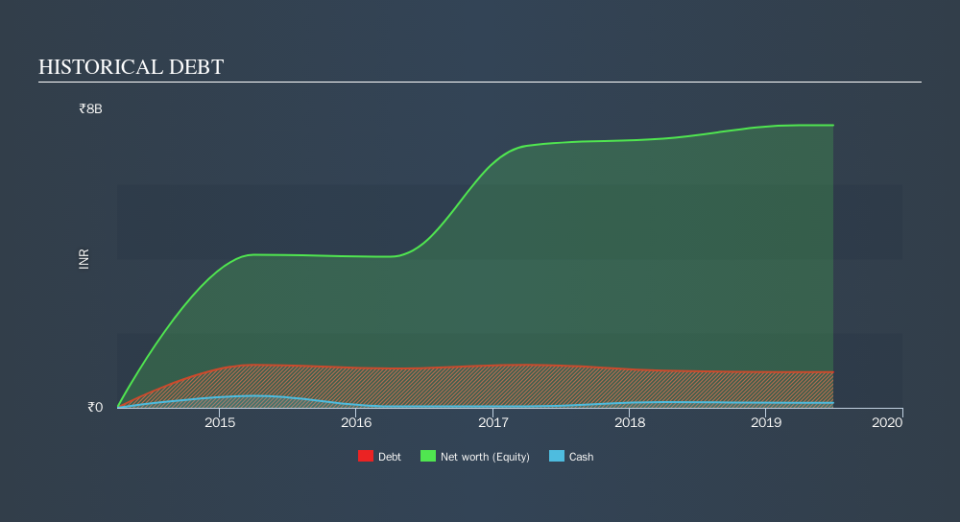Is Dhunseri Tea & Industries (NSE:DHUNTEAIND) A Risky Investment?

Warren Buffett famously said, 'Volatility is far from synonymous with risk.' So it seems the smart money knows that debt - which is usually involved in bankruptcies - is a very important factor, when you assess how risky a company is. Importantly, Dhunseri Tea & Industries Limited (NSE:DHUNTEAIND) does carry debt. But should shareholders be worried about its use of debt?
Why Does Debt Bring Risk?
Debt is a tool to help businesses grow, but if a business is incapable of paying off its lenders, then it exists at their mercy. Ultimately, if the company can't fulfill its legal obligations to repay debt, shareholders could walk away with nothing. While that is not too common, we often do see indebted companies permanently diluting shareholders because lenders force them to raise capital at a distressed price. By replacing dilution, though, debt can be an extremely good tool for businesses that need capital to invest in growth at high rates of return. When we examine debt levels, we first consider both cash and debt levels, together.
View our latest analysis for Dhunseri Tea & Industries
What Is Dhunseri Tea & Industries's Debt?
The chart below, which you can click on for greater detail, shows that Dhunseri Tea & Industries had ₹960.3m in debt in March 2019; about the same as the year before. However, because it has a cash reserve of ₹135.7m, its net debt is less, at about ₹824.6m.
A Look At Dhunseri Tea & Industries's Liabilities
Zooming in on the latest balance sheet data, we can see that Dhunseri Tea & Industries had liabilities of ₹1.11b due within 12 months and liabilities of ₹1.60b due beyond that. On the other hand, it had cash of ₹135.7m and ₹512.2m worth of receivables due within a year. So its liabilities outweigh the sum of its cash and (near-term) receivables by ₹2.06b.
This deficit casts a shadow over the ₹1.20b company, like a colossus towering over mere mortals. So we'd watch its balance sheet closely, without a doubt At the end of the day, Dhunseri Tea & Industries would probably need a major re-capitalization if its creditors were to demand repayment.
We use two main ratios to inform us about debt levels relative to earnings. The first is net debt divided by earnings before interest, tax, depreciation, and amortization (EBITDA), while the second is how many times its earnings before interest and tax (EBIT) covers its interest expense (or its interest cover, for short). This way, we consider both the absolute quantum of the debt, as well as the interest rates paid on it.
With net debt sitting at just 1.5 times EBITDA, Dhunseri Tea & Industries is arguably pretty conservatively geared. And this view is supported by the solid interest coverage, with EBIT coming in at 9.0 times the interest expense over the last year. On the other hand, Dhunseri Tea & Industries saw its EBIT drop by 3.1% in the last twelve months. That sort of decline, if sustained, will obviously make debt harder to handle. When analysing debt levels, the balance sheet is the obvious place to start. But you can't view debt in total isolation; since Dhunseri Tea & Industries will need earnings to service that debt. So if you're keen to discover more about its earnings, it might be worth checking out this graph of its long term earnings trend.
Finally, a business needs free cash flow to pay off debt; accounting profits just don't cut it. So it's worth checking how much of that EBIT is backed by free cash flow. During the last three years, Dhunseri Tea & Industries produced sturdy free cash flow equating to 52% of its EBIT, about what we'd expect. This free cash flow puts the company in a good position to pay down debt, when appropriate.
Our View
We'd go so far as to say Dhunseri Tea & Industries's level of total liabilities was disappointing. But at least it's pretty decent at covering its interest expense with its EBIT; that's encouraging. Overall, we think it's fair to say that Dhunseri Tea & Industries has enough debt that there are some real risks around the balance sheet. If all goes well, that should boost returns, but on the flip side, the risk of permanent capital loss is elevated by the debt. Above most other metrics, we think its important to track how fast earnings per share is growing, if at all. If you've also come to that realization, you're in luck, because today you can view this interactive graph of Dhunseri Tea & Industries's earnings per share history for free.
If you're interested in investing in businesses that can grow profits without the burden of debt, then check out this free list of growing businesses that have net cash on the balance sheet.
We aim to bring you long-term focused research analysis driven by fundamental data. Note that our analysis may not factor in the latest price-sensitive company announcements or qualitative material.
If you spot an error that warrants correction, please contact the editor at editorial-team@simplywallst.com. This article by Simply Wall St is general in nature. It does not constitute a recommendation to buy or sell any stock, and does not take account of your objectives, or your financial situation. Simply Wall St has no position in the stocks mentioned. Thank you for reading.


